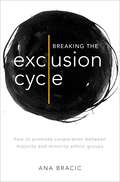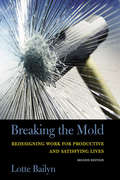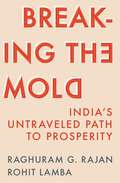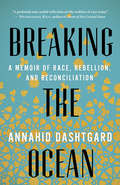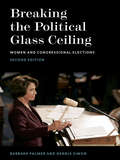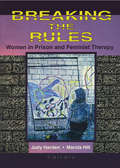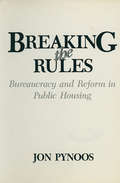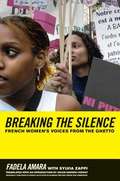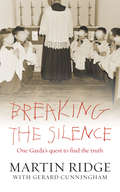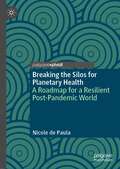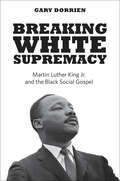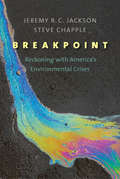- Table View
- List View
Breaking the Exclusion Cycle: How to Promote Cooperation between Majority and Minority Ethnic Groups
by Ana BracicSocial exclusion of minority groups is an intractable problem in many diverse nations. For some minority groups this means going to segregated schools, for others not having access to gainful employment or quality healthcare. But why does social exclusion persist, and what can one do to stop it? This book proposes a theory of how individual behavior contributes to social exclusion, a novel method for measuring that behavior, and solutions to ending it. Based on original fieldwork among Central and Eastern European Roma, the largest ethnic minority in Europe (yet still very understudied), and non-Roma, Ana Bracic develops a theory she calls the exclusion cycle, through which anti-minority culture gives rise to discrimination by members of the majority, and minority members develop survival strategies. Members of the majority resent these strategies, assuming that they are endemic to the minority group rather than an outcome of their own discriminatory behavior. To illustrate her theory, Bracic includes an analysis of a video game she created that simulates interactions between Roma and non-Roma participants, which members of these groups played through avatars (thereby avoiding contentious face-to-face interactions). The results demonstrate that majority members discriminate against minority members even when minority group members behave in ways identical to the majority. It also shows the way in which minority members develop survival mechanisms. Bracic draws on the results of the simulation to offer evidence that this cycle can be broken through NGO-promoted discussion and interaction between groups. She also draws on extant scholarship on interactions between Muslim women in France, African Americans, the Batwa in Uganda, and their respective majority communities.
Breaking the Mold: Redesigning Work for Productive and Satisfying Lives
by Lotte BailynIn Breaking the Mold, Lotte Bailyn argues that society's separation of work and family is no longer a tenable model for employees or the organizations that employ them. Unless American business is willing to radically rethink some of its basic assumptions about work, career paths, and time, both employee and employer will suffer in today's intensely competitive business environment. Bailyn's message was bold when this book was originally published in 1993. Now thoroughly updated to reflect the latest developments in the organization of work, the demography of the workforce, and attitudes toward the integration of work and personal life, this second edition is even more compelling. Bailyn finds that implementation of policies designed to allow "flexibility" is rarely smooth and often results in gender inequity. Using real-life cases to illustrate the problems employees encounter in coordinating work and private life, she details how corporations generally handle these problems and suggests models for innovation. Throughout, she shows how the structure and culture of corporate life could be changed to integrate employees' other obligations and interests, and in the process help organizations become more effective.Drawing on international comparisons as well as many years of working with organizations of various kinds, Bailyn emphasizes the need to redesign work itself. Breaking the Mold allows us to rethink the connections between organizational processes and personal concerns. Implementation of Bailyn's suggestions could help employees to become more effective in all realms of their complicated lives and allow employing organizations to engage their full productive potential.
Breaking the Mold: India’s Untraveled Path to Prosperity
by Raghuram G. Rajan Rohit LambaThe new path for economic development that India must create The whole world has a stake in India&’s future, and that future hinges on whether India can develop its economy and deliver for its population—now the world&’s largest—while staying democratic. India&’s economy has overtaken the United Kingdom&’s to become the fifth-largest in the world, but it is still only one-fifth the size of China&’s, and India&’s economic growth is too slow to provide jobs for millions of its ambitious youth. Blocking India&’s current path are intense global competition in low-skilled manufacturing, increasing protectionism and automation, and the country&’s majoritarian streak in politics. In Breaking the Mold, Raghuram Rajan and Rohit Lamba show why and how India needs to blaze a new path if it&’s to succeed.India diverged long ago from the standard development model, the one followed by China—from agriculture to low-skilled manufacturing, then high-skilled manufacturing and, finally, services—by leapfrogging intermediate steps. India must not turn back now. Rajan and Lamba explain how India can accelerate growth by prioritizing human capital, expanding opportunities in high-skilled services, encouraging entrepreneurship, and strengthening rather than weakening its democratic traditions. It can chart a path based on ideas and creativity even at its early stage of development.Filled with vivid examples and written with incisive candor, Breaking the Mold shows how India can break free of the stumbling blocks of the past and embrace the enormous possibilities of the future.
Breaking the Mold: India’s Untraveled Path to Prosperity
by Raghuram G. Rajan Rohit LambaThe new path for economic development that India must create The whole world has a stake in India&’s future, and that future hinges on whether India can develop its economy and deliver for its population—now the world&’s largest—while staying democratic. India&’s economy has overtaken the United Kingdom&’s to become the fifth-largest in the world, but it is still only one-fifth the size of China&’s, and India&’s economic growth is too slow to provide jobs for millions of its ambitious youth. Blocking India&’s current path are intense global competition in low-skilled manufacturing, increasing protectionism and automation, and the country&’s majoritarian streak in politics. In Breaking the Mold, Raghuram Rajan and Rohit Lamba show why and how India needs to blaze a new path if it&’s to succeed.India diverged long ago from the standard development model, the one followed by China—from agriculture to low-skilled manufacturing, then high-skilled manufacturing and, finally, services—by leapfrogging intermediate steps. India must not turn back now. Rajan and Lamba explain how India can accelerate growth by prioritizing human capital, expanding opportunities in high-skilled services, encouraging entrepreneurship, and strengthening rather than weakening its democratic traditions. It can chart a path based on ideas and creativity even at its early stage of development.Filled with vivid examples and written with incisive candor, Breaking the Mold shows how India can break free of the stumbling blocks of the past and embrace the enormous possibilities of the future.
Breaking the Ocean: A Memoir of Race, Rebellion, and Reconciliation
by Annahid DashtgardIn Breaking the Ocean, diversity and inclusion specialist Annahid Dashtgard addresses the long-term impacts of exile, immigration, and racism by offering a vulnerable, deeply personal account of her life and work.Annahid Dashtgard was born into a supportive mixed-race family in 1970s Iran. Then came the 1979 Revolution, which ushered in a powerful and orthodox religious regime. Her family was forced to flee their homeland, immigrating to a small town in Alberta, Canada. As a young girl, Dashtgard was bullied, shunned, and ostracized both by her peers at school and adults in the community. Home offered little respite, with her parents embroiled in their own struggles, exposing the sharp contrasts between her British mother and Persian father.Determined to break free from her past, Dashtgard created a new identity for herself as a driven young woman who found strength through political activism, eventually becoming a leader in the anti–corporate globalization movement of the late 1990s. But her unhealed trauma was re-activated following the 9/11 terrorist attacks. Suffering burnout, Dashtgard checked out of her life and took the first steps towards personal healing, a journey that continues to this day.Breaking the Ocean introduces a unique perspective on how racism and systemic discrimination result in emotional scarring and ongoing PTSD. It is a wake-up call to acknowledge our differences, addressing the universal questions of what it means to belong and ultimately what is required to create change in ourselves and in society.
Breaking the Political Glass Ceiling: Women and Congressional Elections
by Barbara Palmer Dennis SimonWhy has the integration of women into Congress been so slow? Is there a "political glass ceiling" for women? Although women use the same strategic calculations as men to decide when to run, the decision regarding where to run is something else. While redistricting has increasingly protected incumbents, it also has the unintended consequence of shaping the opportunities for female candidates. The political geography and socio-economic profile of districts that elect women differ substantially from districts that elect men. With data on over 10,000 elections and 30,000 candidates from 1916 to the present, Palmer and Simon explore how strategy and the power of incumbency affect women’s decisions to run for office. Breaking the Political Glass Ceiling is the most comprehensive analysis of women in congressional elections available. The Second Edition is fully updated to reflect the pivotal 2006 mid-term elections, including Nancy Pelosi’s rise to Speaker of the House, Hillary Clinton’s bid for the presidency, and a record number of women serving as committee chairs. Additionally, the authors have created a website, found at politicsandwomen.com, to highlight key features of the book and provide updates throughout the election cycle.
Breaking the Political Glass Ceiling: Women and Congressional Elections (Gender Politics--global Issues Ser.)
by Barbara Palmer Dennis SimonWhy has the integration of women into Congress been so slow? Is there a "political glass ceiling" for women? Although women use the same strategic calculations as men to decide when to run, the decision regarding where to run is something else. While redistricting has increasingly protected incumbents, it also has the unintended consequence of shaping the opportunities for female candidates. The political geography and socio-economic profile of districts that elect women differ substantially from districts that elect men. With data on over 10,000 elections and 30,000 candidates from 1916 to the present, Palmer and Simon explore how strategy and the power of incumbency affect women’s decisions to run for office. Breaking the Political Glass Ceiling is the most comprehensive analysis of women in congressional elections available. The Second Edition is fully updated to reflect the pivotal 2006 mid-term elections, including Nancy Pelosi’s rise to Speaker of the House, Hillary Clinton’s bid for the presidency, and a record number of women serving as committee chairs. Additionally, the authors have created a website, found at politicsandwomen.com, to highlight key features of the book and provide updates throughout the election cycle.
Breaking the Rules: Women in Prison and Feminist Therapy
by Marcia Hill Judith HardenBreaking the Rules: Women in Prison and Feminist Therapy challenges therapists, public policymakers, voters, and those in the criminal justice system to find treatment options, empowerment strategies, viable resources, community support, and policies that can help women with problems such as drug abuse, domestic violence, poverty, and prostitution rather than perpetually punishing them.Breaking the Rules shows you how our society makes ‘other’of those among us who are most vulnerable, injured, and without resources. It digs under your skin and forces you to look at: the histories of abuse among women who have murdered their partners the impact of race and ethnicity on patterns of mothering and caretaking of children of women prisoners the lack of treatment options for addicted women prisoners how prison reawakens the feelings of powerlessness in women who have suffered childhood physical and sexual abuse helping women inmates develop marketable educational and vocational skills, support systems, and positive perceptions of themselves collaborative strategies that challenge the status quo of programs and support available to female offenders and their families a relational model of treatment that is based on the integration of three theoretical perspectives the strengths and limitations of twelve step programs for womenMapping the problems and offering solutions, Breaking the Rules walks you through treatment strategies and self-confirming experiences--such as feminist therapy, prisoner-led support groups, affirmative prison programming, and art therapy--that help women draw on their strengths, come to terms with their pasts, and meet future challenges head on.
Breaking the Rules: Women in Prison and Feminist Therapy
by Marcia Hill Judith HardenBreaking the Rules: Women in Prison and Feminist Therapy challenges therapists, public policymakers, voters, and those in the criminal justice system to find treatment options, empowerment strategies, viable resources, community support, and policies that can help women with problems such as drug abuse, domestic violence, poverty, and prostitution rather than perpetually punishing them.Breaking the Rules shows you how our society makes ‘other’of those among us who are most vulnerable, injured, and without resources. It digs under your skin and forces you to look at: the histories of abuse among women who have murdered their partners the impact of race and ethnicity on patterns of mothering and caretaking of children of women prisoners the lack of treatment options for addicted women prisoners how prison reawakens the feelings of powerlessness in women who have suffered childhood physical and sexual abuse helping women inmates develop marketable educational and vocational skills, support systems, and positive perceptions of themselves collaborative strategies that challenge the status quo of programs and support available to female offenders and their families a relational model of treatment that is based on the integration of three theoretical perspectives the strengths and limitations of twelve step programs for womenMapping the problems and offering solutions, Breaking the Rules walks you through treatment strategies and self-confirming experiences--such as feminist therapy, prisoner-led support groups, affirmative prison programming, and art therapy--that help women draw on their strengths, come to terms with their pasts, and meet future challenges head on.
Breaking the Rules: Bureaucracy and Reform in Public Housing (Environment, Development and Public Policy: Cities and Development)
by Jon PynoosThis is a study of how a bureaucracy allocates a commodity or a service in this case, public housing. In the broadest sense, it seeks to understand how bureaucrats try to resolve two often conflicting goals of regulatory justice: equity (treating like cases alike on the basis of rules) and respon siveness (making exceptions for persons whose needs require that rules be stretched). It analyzes the extent to which such factors as bureaucratic norms, the task orientation of workers, third-party pressure, and outside intervention affect staff members' use of discretion. Many of the rules under consideration were intended by federal officials to achieve such programmatic objectives as racial desegregation and housing for the neediest; in this regard, the study is also an examination of federal-local relationships. Finally, the study examines how the use of discretion changes over time as an agency's mission shifts and reforms are attempted. This book is directed at the audience of administrators of programs who offer services to the public and struggle with how to allocate them. The book is also intended for those concerned with housing policy, partic ularly the difficult problems of whom to house. Finally, it is hoped that students of public management, social welfare, government, and urban planning, who are interested in how public policy is administered through a bureaucracy, will find the book insightful. The case chosen for study is the Boston Housing Authority.
Breaking the Silence: French Women’s Voices from the Ghetto (PDF)
by Fadela Amara Sylvia Zappi Translated an Introduction by Helen Harden ChenutBorn in France of Algerian parents, Fadela Amara is a human rights activist who speaks with both a personal and a collective voice. This book is a passionate account of her struggle to found the movement called “Ni Putes Ni Soumises” (Neither Whore Nor Submissive), aimed at shattering the law of silence about violence against women within French suburban communities. The questions Amara raises are part of a broader agenda to open contemporary French society to greater ethnic and cultural diversity. These issues also pose problems of national identity and the defense of secularism for the state. As France increasingly confronts such tensions and the emergence of Islamic movements, French cities face problems of unemployment, racial and ethnic discrimination, and violence. Amara's eloquent call for social and gender equality underscores a host of interconnected issues, including France's colonial past and the degradation of the suburbs into ghettos that have progressively marginalized immigrant and working-class communities. Amara and her co-workers have challenged the French Republic's leaders using a strategy that champions republican secular values and stresses the language of universalism to advance individual rights. Women's rights are human rights, they argue, thus casting their demands for equality in terms of a broader struggle for democratic freedoms. Moving, candid, and timely, Breaking the Silence created a sensation when it was published in France. Fadela Amara is currently State Minister for Urban Affairs, charged with the rehabilitation of the very ghettos she describes.
Breaking the Silence: One Man's Quest to Find the Truth About One of the Most Horrific Series of Sex Abuse Cases in Ireland
by Martin Ridge Gerard CunninghamAssigned to a quiet corner of Ireland's most remote county, Martin Ridge was heading for retirement after a long career with An Garda Síochána, the Irish police force. All that changed when a call from a local priest set in motion what would become the most horrific sex abuse investigation the island had ever known.At Christmas 1997 a local priest Fr Eugene Greene reported to the Gardaí that a man had tried to blackmail him. This call, an act of hubris, set in motion a Garda investigation that revealed him to be a serial abuser of children. As word of the investigation spread, 26 men came forward. Most were from the tiny Irish-speaking parish of Gort an Choirce. All had been abused by Greene as children.Soon after, another man came forward to say that he had been sexually abused by a local schoolteacher, Denis McGinley. As Ridge dug deeper, he discovered that McGinley had been systematically abusing children in his classroom for decades. He had at least 50 victims.The Greene and McGinley cases both involved the Catholic Church. Greene was a priest, and McGinley a teacher in a Catholic school answerable to religious managers. As Ridge investigated, he discovered that the Church knew about the abuse, but ignored the problem.Brilliantly written and unsparing in its fidelity to the truth, Breaking the Silence is more than an account of a police investigation: it’s the story of an entire community’s struggle to come to terms with its betrayal by those in whom it placed the most trust.
Breaking the Silos for Planetary Health: A Roadmap for a Resilient Post-Pandemic World
by Nicole de PaulaThis book translates the latest theoretical perspectives on the emerging field of Planetary Health Studies into the practical reality of global political decision makers. It builds on the scientific data on the impacts of environmental change on human health to propose practical methods for operationalizing planetary health. The book maps opportunities for decision makers to break institutional silos and engage with bottom-up approaches that can transform planetary health from a global idea into a local reality. The analysis frames human health in the Anthropocene, an era in which humans have become the most powerful force affecting global ecosystems, and reveals new existential risks for humankind.Departing from ongoing multilateral efforts to promote sustainability, the author’s analysis places the agenda of planetary health on the desk of political decision makers, still underrepresented at planetary health gatherings. Given the pressing need to implement sustainable development policies, the book presents planetary health as an overarching framework for global policy targets, notably the UN Sustainable Development Goals, the Paris Agreement on Climate Change, and the post-2020 biodiversity framework under the UN Convention on Biological Diversity. The book is timely in offering a concrete road map for practitioners and researchers interested in transforming the concept of planetary health into reality. With a collection of success stories, the analysis dwells on tools for community engagement, opportunities for health professionals training, gender empowerment, digital health, and innovative ways to enhance human well-being on a changing planet.
Breaking the South Slav Dream: The Rise and Fall of Yugoslavia
by Kate HudsonThis is a revisionist history of the rise and fall of Yugoslavia. Assessing the geopolitical and strategic reasons for its creation and dismemberment, it is an important corrective to much contemporary theorising about the destruction of the Yugoslav state.*BR**BR*Kate Hudson draws attention to the role of foreign states whose involvement in Yugoslavia did much to destabilise the region, and explains how and why this happened. *BR**BR*Tracing the state's origins from 1918 through war and the Tito years, she explains the distortion of the socialist economy resulting from Yugoslavia's unusual position between the two Cold War blocs, and the economic collapse of the 1980s as part of the US's drive for a free market. She also investigates the true causes and effects of the recent wars in Croatia, Bosnia and Kosovo and brings the book up-to-date with an analysis of Milosevic's downfall, and events in Macedonia and Montenegro.
Breaking the Two-Party Doom Loop: The Case for Multiparty Democracy in America
by Lee DrutmanAmerican democracy is at an impasse. After years of zero-sum partisan trench warfare, our political institutions are deteriorating. Our norms are collapsing. Democrats and Republicans no longer merely argue; they cut off contact with each other. In short, the two-party system is breaking our democracy, and driving us all crazy. Deftly weaving together history, democratic theory, and cutting edge political science research, Drutman tells the story of how American politics became so toxic, why the country is trapped in a doom loop of escalating two-party warfare, and why it is destroying the shared sense of fairness and legitimacy on which democracy depends. He argues that the only way out is to have more partisanship-more parties, to short-circuit the zero-sum nature of binary partisan conflict. American democracy was once stable because the two parties held within them multiple factions, which made it possible to assemble flexible majorities and kept the temperature of political combat from overheating. But as conservative Southern Democrats and liberal Northeastern Republicans disappeared, partisan conflict flattened and pulled apart. Once the parties fully separated, toxic partisanship took over. With the two parties divided over competing visions of national identity, Democrats and Republicans no longer see each other as opponents, but as enemies. And the more the conflict escalates, the shakier our democracy feels. Breaking the Two-Party Doom Loop makes a compelling case for large scale electoral reform-importantly, reform not requiring a constitutional amendment-that would give America more parties, making American democracy more representative, more responsive, and ultimately more stable.
Breaking the Two-Party Doom Loop: The Case for Multiparty Democracy in America
by Lee DrutmanAmerican democracy is at an impasse. After years of zero-sum partisan trench warfare, our political institutions are deteriorating. Our norms are collapsing. Democrats and Republicans no longer merely argue; they cut off contact with each other. In short, the two-party system is breaking our democracy, and driving us all crazy. Deftly weaving together history, democratic theory, and cutting edge political science research, Drutman tells the story of how American politics became so toxic, why the country is trapped in a doom loop of escalating two-party warfare, and why it is destroying the shared sense of fairness and legitimacy on which democracy depends. He argues that the only way out is to have more partisanship-more parties, to short-circuit the zero-sum nature of binary partisan conflict. American democracy was once stable because the two parties held within them multiple factions, which made it possible to assemble flexible majorities and kept the temperature of political combat from overheating. But as conservative Southern Democrats and liberal Northeastern Republicans disappeared, partisan conflict flattened and pulled apart. Once the parties fully separated, toxic partisanship took over. With the two parties divided over competing visions of national identity, Democrats and Republicans no longer see each other as opponents, but as enemies. And the more the conflict escalates, the shakier our democracy feels. Breaking the Two-Party Doom Loop makes a compelling case for large scale electoral reform-importantly, reform not requiring a constitutional amendment-that would give America more parties, making American democracy more representative, more responsive, and ultimately more stable.
Breaking Through the Access Barrier: How Academic Capital Formation Can Improve Policy in Higher Education
by Edward P. St. John Shouping Hu Amy S. FisherBreaking Through the Access Barrier argues that the policies designed to address inequalities in college access are failing to address underlying issues of inequality. This book introduces academic capital formation (ACF), a groundbreaking new theory defined by family knowledge of educational options and the opportunities for pursuing them. The authors suggest focusing on intervention programs and public policy to promote improvement in academic preparation, college information, and student aid. This textbook offers: a new construct–academic capital–that integrates and draws upon existing literature on influencing access to college practical advice for better preparation and intervention real student outcomes, databases, and interviews taken from exemplary intervention programs empirical research illuminating the role of class reproduction in education and how interventions (financial, academic, and networking) can reduce student barriers quantitative and qualitative analysis of the importance and effectiveness of several major policy interventions. Written for courses on higher education policy and policy analysis, readers will find Breaking Through the Access Barrier offers valuable advice for working within new policy frameworks and reshaping the future of educational opportunities and access for under-represented students from disadvantaged backgrounds.
Breaking Through the Access Barrier: How Academic Capital Formation Can Improve Policy in Higher Education
by Edward P. St. John Shouping Hu Amy S. FisherBreaking Through the Access Barrier argues that the policies designed to address inequalities in college access are failing to address underlying issues of inequality. This book introduces academic capital formation (ACF), a groundbreaking new theory defined by family knowledge of educational options and the opportunities for pursuing them. The authors suggest focusing on intervention programs and public policy to promote improvement in academic preparation, college information, and student aid. This textbook offers: a new construct–academic capital–that integrates and draws upon existing literature on influencing access to college practical advice for better preparation and intervention real student outcomes, databases, and interviews taken from exemplary intervention programs empirical research illuminating the role of class reproduction in education and how interventions (financial, academic, and networking) can reduce student barriers quantitative and qualitative analysis of the importance and effectiveness of several major policy interventions. Written for courses on higher education policy and policy analysis, readers will find Breaking Through the Access Barrier offers valuable advice for working within new policy frameworks and reshaping the future of educational opportunities and access for under-represented students from disadvantaged backgrounds.
Breaking Through the Noise: Presidential Leadership, Public Opinion, and the News Media (Studies in the Modern Presidency)
by Matthew Eshbaugh-Soha Jeffrey S. PeakeModern presidents engage in public leadership through national television addresses, routine speechmaking, and by speaking to local audiences. With these strategies, presidents tend to influence the media's agenda. In fact, presidential leadership of the news media provides an important avenue for indirect presidential leadership of the public, the president's ultimate target audience. Although frequently left out of sophisticated treatments of the public presidency, the media are directly incorporated into this book's theoretical approach and analysis. The authors find that when the public expresses real concern about an issue, such as high unemployment, the president tends to be responsive. But when the president gives attention to an issue in which the public does not have a preexisting interest, he can expect, through the news media, to directly influence public opinion. Eshbaugh-Soha and Peake offer key insights on when presidents are likely to have their greatest leadership successes and demonstrate that presidents can indeed "break through the noise" of news coverage to lead the public agenda.
Breaking Up Is Hard To Do: Britain And Europes Dysfunctional Relationship (PDF)
by Minford Et AlThe authors of this book were asked to examine the issue of Britain leaving the EU and determine, from an economic or political economy point of view, what the appropriate role of international institutions should be in this debate. They were then asked to relate this to the reality that exists under the status quo or that might exist if Brexit occurred. In doing this, the volume can help achieve three objectives. First, it provides an analysis of the role that international institutions should play in the economic life of a free society. This is important, and rarely discussed in policy debates. In general, policy discussion tends to revolve around how to tweak the status quo - should we have more EU involvement in climate change policy or military intervention by the UN in this or that case, for example. Second, the authors implicitly lay out what a renegotiation agenda ought to look like if a country (whether Britain or not) wishes to reform the EU in a liberal direction, now or at some future time. At the time of writing this foreword, it is clear that David Cameron's agenda is not nearly radical enough, though it remains to be seen whether even that will be achieved. Indeed, it is not clear that the proposals of the UK government will even take the EU in the right direction. Any serious agenda to create a new settlement should start from first principles and take into consideration for what purposes the institution should exist. This would provide a benchmark against which success can be measured. Third, the authors provide a framework within which the practical options of remaining with a reformed EU and Brexit can be analysed. There are some authors who do not believe that international institutions are at all important in the area they discuss. Others believe that international cooperation can take place through bespoke, informal or ad hoc mechanisms, and that the EU itself need have no role. Presumably, in these cases, Brexit would be the logical way to get the best policy outcome. Another group of authors believes that a reformed or slimmed-down role for the EU would be satisfactory, or that the restraints that the EU currently puts on member states are really important in guaranteeing economic liberalism. As far as these areas are concerned, a renegotiated (or, in some cases, unreformed) EU would be the best option. One interesting issue is raised that perhaps transcends the discussions of particular policy areas. Rather than trying to renegotiate a better deal when it comes to labour market regulation or agriculture, it might be better to try to reshape the institutions of the EU. There might be wider support for that, and, in the long term, better institutions could lead to better policy. Overall, this is an important and unique contribution to the discussion about Britain's relationship with the EU. In the white noise of the referendum debate, serious long-term analysis of the precise role that international institutions should play in a free society, grounded in the context of the reality of the EU's current role, is refreshing. Its relevance will long outlive the referendum on Brexit that is likely to take place in the next 18 months.
Breaking White Supremacy: Martin Luther King Jr. and the Black Social Gospel
by Gary DorrienThis magisterial follow-up to The New Abolition, a Grawemeyer Award winner, tells the crucial second chapter in the black social gospel’s history. The civil rights movement was one of the most searing developments in modern American history. It abounded with noble visions, resounded with magnificent rhetoric, and ended in nightmarish despair. It won a few legislative victories and had a profound impact on U.S. society, but failed to break white supremacy. The symbol of the movement, Martin Luther King Jr., soared so high that he tends to overwhelm anything associated with him. Yet the tradition that best describes him and other leaders of the civil rights movement has been strangely overlooked. In his latest book, Gary Dorrien continues to unearth the heyday and legacy of the black social gospel, a tradition with a shimmering history, a martyred central figure, and enduring relevance today. This part of the story centers around King and the mid-twentieth-century black church leaders who embraced the progressive, justice-oriented, internationalist social gospel from the beginning of their careers and fulfilled it, inspiring and leading America’s greatest liberation movement.
Breakpoint: Reckoning with America's Environmental Crises
by Jeremy B. Jackson Steve ChappleAn insightful look at the American environmental crisis and emerging solutions from the heartland to the coasts in the era of global climate change Eminent ecologist Jeremy B. C. Jackson and award-winning journalist Steve Chapple traveled the length of the Mississippi River interviewing farmers, fishermen, scientists, and policymakers to better understand the mounting environmental problems ravaging the United States. Along their journey, which quickly expands to California, Florida, and New York, the pair uncovered surprising and profound connections between ecological systems and environmental crises across the country. Artfully weaving together independent research and engaging storytelling, Jackson and Chapple examine the looming threats from recent hurricanes and fires, industrial agriculture, river mismanagement, extreme weather events, drought, and rising sea levels that are pushing the country toward the breaking point of ecological and economic collapse. Yet, despite these challenges, the authors provide optimistic and practical solutions for addressing these multidimensional issues to achieve greater environmental stability, human well†‘being, and future economic prosperity. With a passionate call to action, they look hopefully toward emerging and achievable solutions to preserve the country’s future.
Breakthroughs: Re-creating the American City
by Robert GuskindLarge or small, America's cities have had a difficult time generating admiration, respect, or understanding. They have served the nation as sources of commerce, finance, and the arts. They have taken millions of new Americans from their point of entry and helped newcomers elevate themselves economically into the American mainstream. In recent years, the greatest of cities have become command centers of a new global economy. However, the headlines from urban America proclaim riot, decline, and despair.This book is different, it is about solutions: the breakthroughs - the indicators that can serve as models for neighborhoods, communities, and cities in the twenty-first century. In vivid, colorful, and provocative prose, authors Neal R. Peirce and Robert Guskind describe six innovative experiments in urban revitalization: the winners of the Rudy Bruner Award for Excellence in the Urban Environment. The Bruner Award recognizes and rewards innovative projects that blend empowerment, diversity, and equity with effective design, social responsibility, and economic viability.Peirce and Guskind describe the premises underlying each project, the barriers that were overcome, and the results that were achieved. They also provide the vital lessons of what made these efforts work, and lessons that stand as requirements for successful projects elsewhere: openness to innovation; decentralized decision-making; broad-based participation; empowerment of locally driven solutions. This is essential reading for students, policy-makers, planners, and all those seeking a glimpse of a future in which we can take pride in being Americans.
Breakthroughs: Re-creating the American City
by Robert GuskindLarge or small, America's cities have had a difficult time generating admiration, respect, or understanding. They have served the nation as sources of commerce, finance, and the arts. They have taken millions of new Americans from their point of entry and helped newcomers elevate themselves economically into the American mainstream. In recent years, the greatest of cities have become command centers of a new global economy. However, the headlines from urban America proclaim riot, decline, and despair.This book is different, it is about solutions: the breakthroughs - the indicators that can serve as models for neighborhoods, communities, and cities in the twenty-first century. In vivid, colorful, and provocative prose, authors Neal R. Peirce and Robert Guskind describe six innovative experiments in urban revitalization: the winners of the Rudy Bruner Award for Excellence in the Urban Environment. The Bruner Award recognizes and rewards innovative projects that blend empowerment, diversity, and equity with effective design, social responsibility, and economic viability.Peirce and Guskind describe the premises underlying each project, the barriers that were overcome, and the results that were achieved. They also provide the vital lessons of what made these efforts work, and lessons that stand as requirements for successful projects elsewhere: openness to innovation; decentralized decision-making; broad-based participation; empowerment of locally driven solutions. This is essential reading for students, policy-makers, planners, and all those seeking a glimpse of a future in which we can take pride in being Americans.
The breakup of India and Palestine: The causes and legacies of partition (Studies in Imperialism #213)
by Victor Kattan Amit RanjanThis book is the first study of political and legal thinking about the partitions of India and Palestine in 1947. The chapters in the volume, authored by leading scholars of partition, draw attention to the pathways of peoples, geographic spaces, colonial policies, laws, and institutions that connect them from the vantage point of those most engaged by the process: political actors, party activists, jurists, diplomats, philosophers, and international representatives from the Middle East, South Asia, and beyond. Additionally, the volume investigates some of the underlying causes of partition in both places such as the hardening of religious fault-lines, majoritarian politics, and the failure to construct viable forms of government in deeply divided societies.
